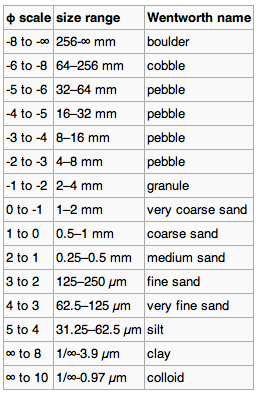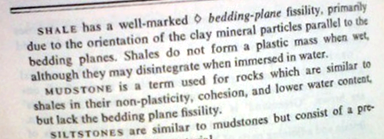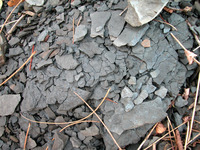What is shale?
/Until four or five years ago, it was enough just to know that shale is that dark grey stuff in between the sands. Being overly fascinated with shale was regarded as a little, well, unconventional. To be sure, seals and source rocks were interesting and sometimes critical, but always took a back seat to reservoir characterization.
Well, now the shale is the reservoir. So how do we characterize shale? We might start by asking: what is shale, really? Is it enough to say, "I don't know, but I know it when I see it"? No: sometimes you need to know what to call something, because it affects how it is perceived, explored for, developed, and even regulated.
Alberta government
 Section 1.020(2)(27.1) of the Oil and Gas Conservation Regulations defines shale:
Section 1.020(2)(27.1) of the Oil and Gas Conservation Regulations defines shale:
a lithostratigraphic unit having less than 50% by weight organic matter, with less than 10% of the sedimentary clasts having a grain size greater than 62.5 micrometres and more than 10% of the sedimentary clasts having a grain size less than 4 micrometres.
ERCB Bulletin 2009-23
This definition seems quite strict, but it is open to interpretation. 'Ten percent of the sedimentary clasts' might be a very small volumetric component of the rock, much less than 10%, if those 'clasts' are small enough. I am sure they meant to write '...10% of the bulk rock volume comprising clasts having a grain size...'.
The point is moot, however, since the same bulletin goes on to list 43 formations that the Board considers to be shale. Unlisted formations are, by definition, not shale. This is pertinent because qualifying production has a lower royalty rate than conventional production.
Wikipedia
We can argue about Wikipedia as an authority, but there's no question over its influence. The entry for shale cites Blatt et al (1965), giving a definition that also centers on grain size, admitting any mineralogy, but requires the rock to be fissile:
...a fine-grained clastic sedimentary rock composed of mud that is a mix of flakes of clay minerals and tiny fragments (silt-sized particles) of other minerals, especially quartz and calcite. The ratio of clay to other minerals is variable. Shale is characterized by breaks along thin laminae or parallel layering or bedding less than one centimeter in thickness, called fissility. Mudstones, on the other hand, are similar in composition but do not show the fissility.
Dictionaries
Arguably unreliable for technical definitions, dictionaries nonetheless try to describe how words are used and understood by most people. And there are specialist dictionaries too.
Merriam-Webster gives this: "a fissile rock that is formed by the consolidation of clay, mud, or silt, has a finely stratified or laminated structure, and is composed of minerals essentially unaltered since deposition." In other words: a fine-grained, fissile, sedimentary rock.
This definition is basically the same as that in my Concise Oxford: "soft finely stratified rock that splits easily, consisting of consolidated mud or clay."
It's not a dictionary, but this USGS glossary gives the simplest definition of all, requiring only that the grain size is silt or finer: "A fine-grained sedimentary rock, formed by the consolidation of clay, silt, or mud."
 My Pan Dictionary of Earth Sciences gives this: "A well-laminated argillaceous sedimentary rock... [whose] fissility is related to the disposition of clay minerals within the rock." Similarly, the Penguin Dictionary of Geology (left) has the same, but adds: "Shales do not form a plastic mass when wet, although they may disintegrate when immersed in water."
My Pan Dictionary of Earth Sciences gives this: "A well-laminated argillaceous sedimentary rock... [whose] fissility is related to the disposition of clay minerals within the rock." Similarly, the Penguin Dictionary of Geology (left) has the same, but adds: "Shales do not form a plastic mass when wet, although they may disintegrate when immersed in water."
Potter et al (2005) and others
Although the terms clay, mud and shale are widely recognized, their technical definitions and usage have long been troublesome and are not fully agreed upon. There are at least two reasons for this — the term clay is used both as a size and a mineral term, plus many clays, muds and shales are rich in silt-sized particles and thus span the clay-silt boundary.
Potter goes on to discuss some of the nuance here, then settles on mud as a generic fine-grained sediment, and mudstone as its lithified incarnation. But his point is clear: shale is, at best, a woolly term. This view is echoed by Merriman et al (2003): "Problems have arisen with the precise definition of the terms shale, slate and clay." Those authors also call out flakiness as the diagnostic characteristic of shale (as opposed to blockiness for mudstone). They add, "shale, mudstone and slate are collectively referred to as mudrocks."
Conclusion
 Weathering shale in Kentucky. Image licensed under GDFL by Pollinator.I find it interesting that none of the definitions mention organic matter, except (as in the ERCB definition) to rule out coal. As I wrote recently on this blog, I think many oil industry geologists today use the word shale as shorthand for hydrocarbon plays that produce directly from source rocks, perhaps thinking of everything else as mudstone. The last thing the world needs is another definition, but we might summarize this notion as
Weathering shale in Kentucky. Image licensed under GDFL by Pollinator.I find it interesting that none of the definitions mention organic matter, except (as in the ERCB definition) to rule out coal. As I wrote recently on this blog, I think many oil industry geologists today use the word shale as shorthand for hydrocarbon plays that produce directly from source rocks, perhaps thinking of everything else as mudstone. The last thing the world needs is another definition, but we might summarize this notion as
a tight, brittle rock composed mostly of mud-grade particles, containing substantial petroliferous kerogen
So what is the geologist to do? The only safe thing to do is to be quite clear about what you mean when you talk or write about shale. If you aren't, there's a good chance that every member of your audience has a slightly different interpretation than the one you have in mind.
References
- Blatt, Harvey and Robert J. Tracy, 1996, Petrology: Igneous, Sedimentary and Metamorphic, 2nd ed., Freeman, pp. 281 - 292 ISBN 0-7167-2438-3
- ERCB Bulletin 2009-23: Shale gas development—Definition of shale and identification of geological strata. Bulletin of the Energy Resources Conservation Board of Alberta, Canada, July 2009.
- Merriman, R, D Highley, and D Cameron (2003). Definition and characteristics of very-fine grained sedimentary rocks: clay, mudstone, shale and slate. British Geological Survey, Commissioned Report CR/03/281N.
- Pan Dictionary of Earth Sciences (1976). Stella Stiegeler, ed. Pan Books, London.
- Potter, P, B Maynard & P Depetris (2005): Mud and mudstones. Springer-Verlag, Berlin.
- Whitten, D & J Brooks (1972). Penguin Dictionary of Geology. Penguin, Harmondsworth.
This new article by Jeremy Boak at CSM is worth a read too — August 2012 AAPG Explorer magazine.








 Except where noted, this content is licensed
Except where noted, this content is licensed